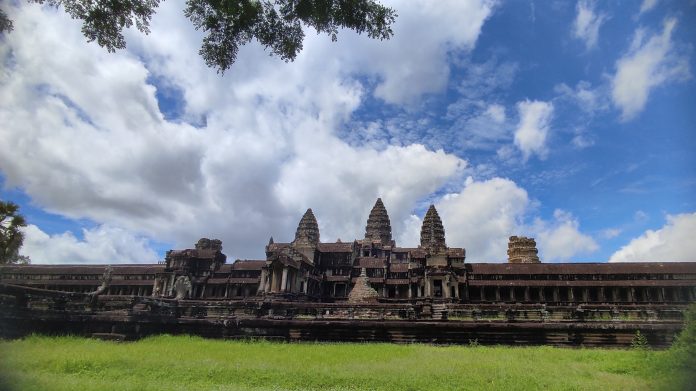Reading Time: 10 minutes
You have to see it to believe it or should I say – Believe It or Not. We have heard of Little India – a famous street in Singapore, where you find a lot of Indians, you can buy Indian spices, foods, sweets and almost anything. And during Diwali it looks like any street in India, festive and illuminated, glittering and colourful, crowded and vibrant. But Cambodia is different.
Almost 97% of the population in Cambodia is Buddhist. They follow and practice Theravada Buddhism. Theravada Buddhism is the oldest surviving form of the religion. Cambodian Buddhism shares much with their other Buddhist countries but has many notable and unique qualities. Buddha statues are revered in Cambodia and visitors are politely asked to respect the customs surrounding these, such as not pointing your feet towards a Buddha statue and dressing respectfully in temples which is very much like we practice in India. With an estimate of 4400 monastic temples throughout the country (and more being built) and over 30000 practicing monks, Buddhism is lived every day. The remaining population includes Christians, Muslims, Jews and what not but hardly any Hindus. Less than a thousand individuals probably. Even after being a very small minority in the Buddhist majority Nation it highly influences the vast culture and history of Cambodia….. Having being a prominent religion under the Khmer Empire. Today most Cambodian Hindus are Indians in Cambodia.
The story goes that an Indian Prince known as Kaundinya a Hindu Brahmin probably from northern Andhra Pradesh or southern Odisha travelled to Southeast Asia for trade, by chance met and later married a Naga Princess Soma from the Cambodian island. She was the first monarch of Cambodia as well as the first female leader as the consort of Kaundinya. There are many legends and variations on how the two met… but all confirm their marriage, including some Chinese texts. Most accounts undoubtedly reflect historical events from the 1st Century AD relating to the process of Indianisation, the influx of Indian religion, folklore, political and legal theories and other cultural elements brought by Indians into Southeast Asia. During a visit to India in 1955, the Cambodian statesman Norodom Sihanouk had said “We (India and Cambodia) are cousins, Khmer civilisation is the child of India’s civilisation, and we are proud of it.” His wife Norodom Monineath has worked hard to popularise the story of Preah Thong and Neang Neak – the Khmer names for Kaundinya and Soma, through a dance drama which is performed across the world by the Royal Ballet of Cambodia. The Cambodians believe that the Khmers were the direct descendants of these two – Kaundinya and Soma.
Since then Hinduism was introduced and thrived as more and more people adopted it. Indians were welcomed in Cambodia as they went in large numbers for trade, taking with them lots and lots of gold, hence a thriving trade was established. Hinduism is known as the oldest religion in the world and this way of life was so strong that it was adopted by adjoining regions. In Cambodia are many temples that date back to the 10th and 12th Century.
After Hinduism, Buddhism also travel to Cambodia from India. There were many factions in both these religions due to different ideologies, soon they started fighting for power. It was a three sided power struggle between these two and the local royalty and finally Buddhism won – and stayed on till now despite having different factions. Even today Buddhism is the most prominent. There are few Hindus, but the monuments, culture and artefacts have survived and are respectfully looked after and maintained.
Incidentally it give me a very good and proud feeling to see that the Archaeological Survey of India is now helping restore, reconstruct, renovate and maintain the temple monuments even the Buddhist ones. All the massive structures and monuments are loosely grouped as Angkor Wat. The magnificent Angkor Wat – Heritage of Humanity and World Wonder is an exotic tourist destination listed as the 7th Wonder of the World. This majestic temple continues to amaze and delight visitors.
In the region during the 6th and 7th Centuries there were many waring states who had dynastic rivalries and eventually disintegrated. The region was later united in the 8th Century CE under King Jayavarman II (802-850) who established the whole thing up when he built one of his residences on the plateau of Kulen, and the famous Angkorian period began. At the beginning of the 9th century the Angkorian kings set up their capital near modern day Siem Reap and for 600 years they built one temple after another each grander than the last. Two hundred such big and small temples survive today, spread over a 400 square kilometres.
These magnificent temples around Siem Reap were abandoned centuries ago by the Khmer kingdom and are now surrounded by lush green forests – with huge trees growing on the monuments. TA PROHM particularly is so amazing that a Hollywood movie of 2001 – TOMB RAIDER was shot here. Built between 12th and 13th Century it was dedicated to King Jayavarman VII’s mother. This haunting beauty, a 600 room structure had a population of over 70,000 people. The temple was home to high priests, monks, dancers and labours. It was a powerhouse which controlled great wealth in gold and jewels and roughly 3000 villages nearby!
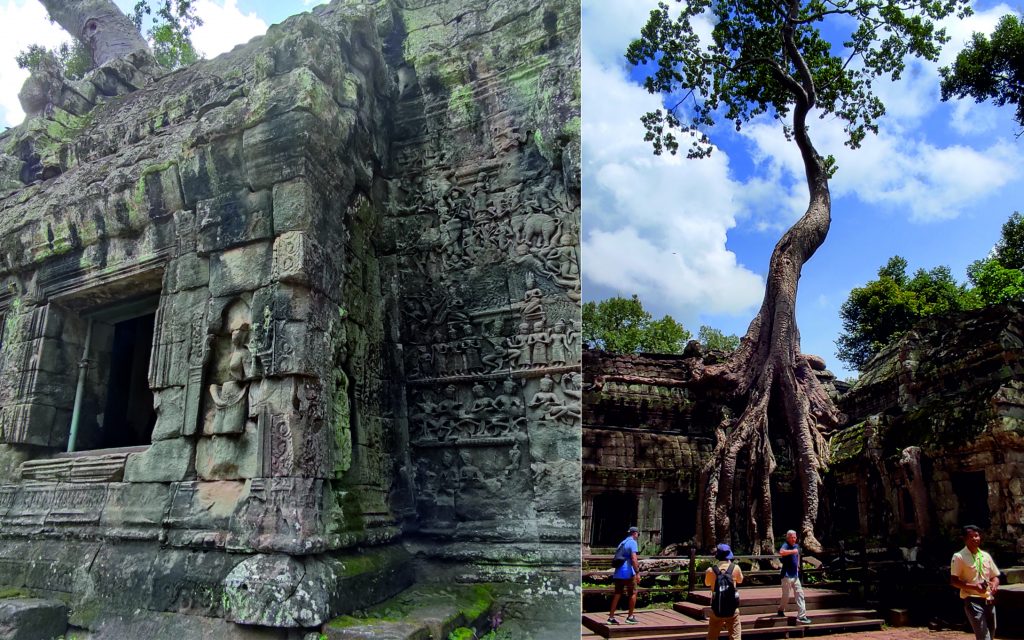
Another awe inspiring structure is the BAYON temple with its giant smiling stone faces. It is at the centre of King Jayavarman’s capital Angkor Thom, and the last one to be built in Angkor. It is the only temple to be built primarily as a Mahayana Buddhist shrine dedicated to the Buddha. Following Jayavarman’s death, it was modified by Hindu and Theravada Kings in accordance to their religious preferences. The similarity of the 216 serene and gigantic faces to the other statues of Jayavarman VII’s has led many scholars to deduce that these are representations of the king himself. Others believe that the faces belong to Avalokitesvara, the bodhisattva of compassion. 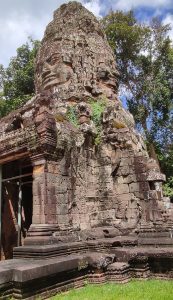
In the 11th century King Suryavarman II founded a glorious dynasty during his reign. The Angkor Wat Temple built by him is the largest and the most important of these temples. Full of courtyards and carvings, it was dedicated to Lord Vishnu. It is believed to have taken 30 years to build. It was later dedicated to Buddhism and is the only one of the Angkorian Temples to remain in religious use throughout the centuries. Even now hordes of people visit the temple for religious ceremonies especially during the period when they celebrate the festival of the dead (akin to the shraad or Pitru Paksh in India). Unusual for a Khmer temple, it is oriented to the West, which has led experts to believe it was a funeral temple for King Suryavarman II, because it faces the setting sun. Also bas reliefs are designed to be viewed from left to right in keeping with Hindu death rituals. Just like the Indian Hindus 16 days are earmarked to remember and celebrate the paternal ancestors. Religious ceremonies are held in the memory of the dead. In the Angkor Wat complex we saw many families who came in traditional attire with offerings to designated small temple structures to pray under the guidance of the priests sitting there.
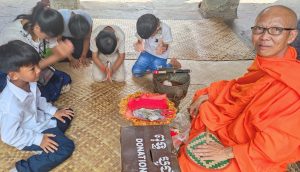
The grandeur of Angkor came to an end around 1431 when the city was ceased by the Siamese. The king was forced to retreat and form a new capital in the vicinity of modern Phnom Penh and Angkor was abandoned by the 15th century. Angkor Wat had been on my bucket list from the time we first read about it in the Art History class in Arts school some 50 years ago. Never imagine that I’ll actually ever be able to visit it some day! I found all the places we visited in Cambodia very exciting, juxtaposing ancient history with contemporary culture, from slick hotels to fine dining restaurants where you can have a lavish buffet while watching the famous Apsara and other dances. The Apsara dancers are another popular subject in the wall murals in the temples and other structures.

The National Museum of Cambodia was inaugurated around 1920 and the red buildings remain just as attractive today. Supported by UNESCO it houses more than 1400 valuable items including sculpture, ceramics and the largest collection of Khmer Art in the world. Majority of them, dating back to the 10th to 12th Centuries, there are ethnographic objects dating from prehistoric times, as well as artefacts from the Angkor period. This museum also houses the maximum number of idols in stone, wood and other material from the Hindu period of Cambodia. At the entrance is a monolith sculpture which has Brahma Vishnu and Mahesh all in one which we found to be very unique. Just in front of the main door leading to the building are big statues in stone of Lord Ganesha.

These are not just museum artefacts. Idols of Lord Shiv and Shivlings of various sizes, Lord Vishnu and his many Avatars, Lord Hanuman can be seen everywhere apart from the museum. In fact there are stories of the Ramayan and Mahabharat and famous episodes from both the epics in relief, carved, sculpted and painted, even at various places seen on the walls in the different temple structures. The image of Lord Vishnu riding the Garuda is very popular and is seen in various like wood, metal, stone, paintings and even as parts of a pattern on carved panel decorations. Some very interesting sculptures we came across were the fight between Duryodhan and Bheem, a smiling Yamraj and one of Lord Shiv with a moustache! There was another huge one of Bali and Sugriv during their fight. Many idols of Lord Ram easily identified with his bow and arrow and other one very typical was of Krishna carrying the Govardhan.
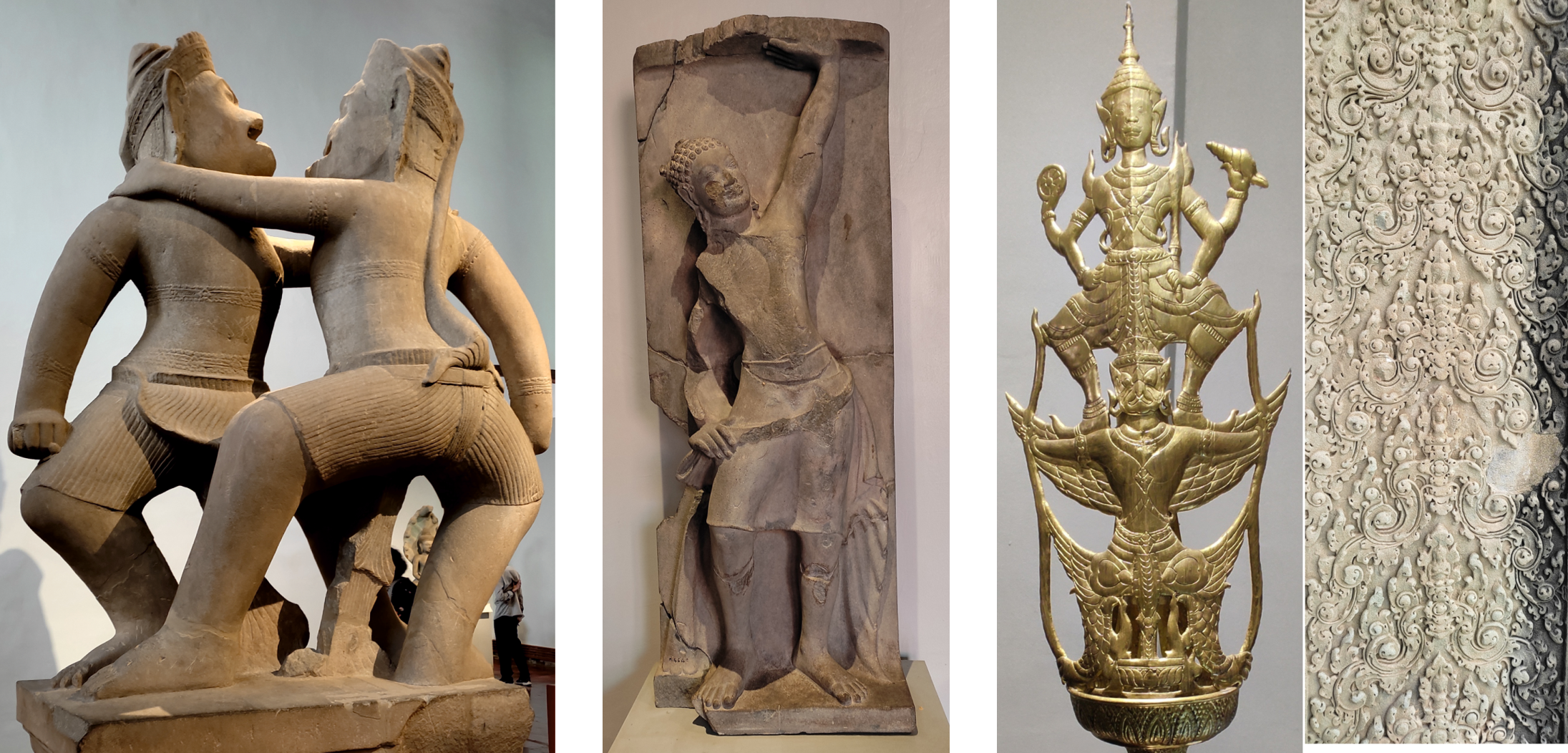
Hanuman and Ganesh are much revered and seen in various poses even today. There is a Pagoda (temple) in every village and each one has an intricately decorated gate with at least one life size elephant sculpture, one each side. Elephants are considered sacred and auspicious (like Ganeshji) and idols are being made and sold even now. They have a very popular beer also by the name Hanuman.

In the vicinity of the Royal Palace in Phnom Penh, which also houses the famous Silver Pagoda, there is a 500 meter long spectacular mural on the enclosure wall depicting the Cambodian version of the Ramayan (known as the Reamker in Cambodia.) It shows vivid images of the battle of Lanka and Lord Ram’s victory. The many images of Hanuman are easily recognized. The Palace was built around1866 (long after Hinduism ceased to be the main religion) yet has this glorious mural, parts of which have been recently restored.
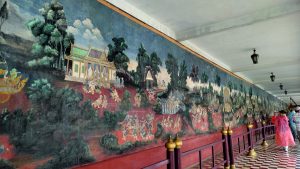
Khmer adopted Indian myths and elaborated on them extensively in their own stories, rituals and art. A common subject seems to have been a 7 headed snake, seen in many sculptures or just forming a stone balustrade especially in Angkor. At places it is depicted as protecting Buddha and is taken as an important and auspicious religious and spiritual symbol for good luck and protection and often used as a door guardian. Lord Vishnu and the mythological character of the many headed snake Sheshnaag are common subjects in India, the serpent represents power, water and fertility as per Hindu texts. The Samudra Manthan (churning of the ocean to extract the elixir of immortality) and Vasuki the serpent king also is represented at many places. Angkor Wat specially has some stunningly executed carvings and sculptures of the subject depicting 88 asuras and 92 devas with crested helmets.

Krishna is a very common name even now. There are other common names like Sukh and the word means the same as for us – the opposite of dukh. Aroon meaning the Sun and the Chand meaning Moon of course, are also very popular names. Actually our guide’s name was Chandraseng (read Singh). Most of these words like for us, come from Sanskrit and were adapted and adapted permanently into the language of the Khmer. Shiv, Mahesh, Sujit, Surya, Maneka, Apsara are all popular names in Cambodia. We found many common words which we use in our daily language they may probably be pronounced a little differently but the meaning is the same. We discovered even their numbers sound like ours…. IK = one, TOH = two, TRE = three, CHAKTO = four, PANCHA = five and so on!
At one time Cambodia was considered an island. That was because for a large part of the year after the monsoon, the mighty Mekong River remains flooded and many areas are water logged for long periods. This keeps the land very fertile and productive. Rice and lotus are the main plantations here. Most people in one district have their houses on stilts. We saw many such houses, where the living area is upstairs and instead of cars, they have small boats or rafts ‘parked’ outside their houses.
 Mekong is sacred and important to the Cambodians. In a way it is their lifeline. They consider it as a mother…. Like we also say Ganga Maiya. Mother or “MA” is a prefix for all good things. They have a queen mother, who is very old now, but her son, the king who is 70, is not married yet. Theirs is a matriarchal society. Mother and women are highly respected. There exists a system of monogamy since ancient times. At the time of marriage the boy’s family has to give like a dowry as assurance that he will respect and look after his wife. Thus the women have a strong hold on the family and social system. They also work hard and control the economy to a great extent.
Mekong is sacred and important to the Cambodians. In a way it is their lifeline. They consider it as a mother…. Like we also say Ganga Maiya. Mother or “MA” is a prefix for all good things. They have a queen mother, who is very old now, but her son, the king who is 70, is not married yet. Theirs is a matriarchal society. Mother and women are highly respected. There exists a system of monogamy since ancient times. At the time of marriage the boy’s family has to give like a dowry as assurance that he will respect and look after his wife. Thus the women have a strong hold on the family and social system. They also work hard and control the economy to a great extent.
The presence of India is seen in other modern ways too. On the roads you come across two and three wheelers, mostly manufactured in India, dominating the roads. Bajaj, TVS and Tata ‘tuktuks’ (rickshaws) are a common sight. On inquiry we learnt that cars ‘Made in India’ are not used because Cambodia has left hand drive vehicles.



